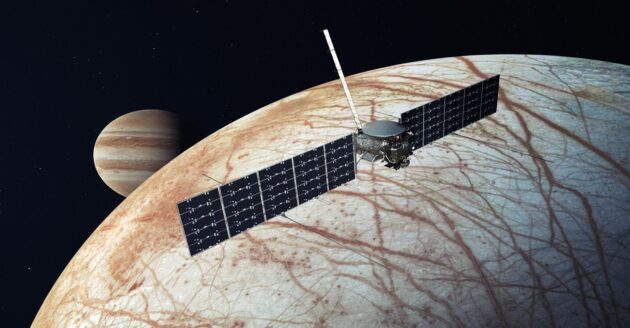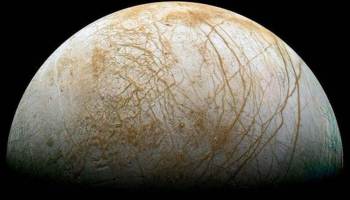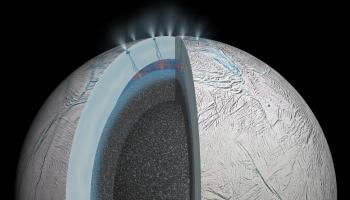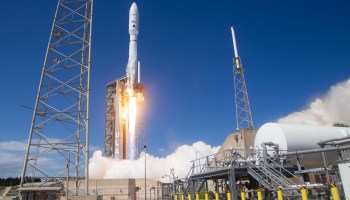
Scientists have verified that a method to look for cellular life on Europa, an ice-covered moon of Jupiter, just might work. The technique could be put to the test in the 2030s, when NASA’s Europa Clipper probe is due to make multiple flybys over the Jovian moon.
The technique involves analyzing grains of ice that scientists expect one of the instruments on Europa Clipper — known as the Surface Dust Analyzer, or SUDA — to pick up as it flies through plumes of frozen water rising up from Europa’s surface.
“It’s astonishing how the analysis of these tiny ice grains may tell us whether or not there is life on an icy moon. At least we now know that SUDA has these capabilities,” University of Washington planetary scientist Fabian Klenner told GeekWire in an email. Klenner is the lead author of a research paper about the process, published today in the open-access journal Science Advances.
SUDA will be capable of analyzing the chemical content of material that hits its detector, using a process called impact ionization mass spectrometry. The key feature of the process described by Klenner and his colleagues is that the analysis would be done on single ice grains, rather than on a blizzard of ice particles. That way, scientists can focus on individual grains that might hold a high concentration of the ingredients of a single cell.
Several moons of Jupiter and Saturn — including Europa, Callisto, Ganymede and Enceladus — are thought to harbor reservoirs of liquid water covered by ice. Observations made during NASA’s Cassini mission to Saturn indicated that the plumes of ice grains emanating from Enceladus’ hidden seas through its icy surface contain a diverse complement of organic compounds. That has led scientists to suspect that something similar might be found on Europa.
“There are many ice grains around Europa because interplanetary meteoroids impact on Europa’s surface and produce a tenuous cloud of ice grains around the moon — a paradise for an instrument like SUDA,” Klenner said.
The idea of seeking out chemical traces of life in the stuff coming up from Europa goes at least as far back as the 1990s, when physicist Freeman Dyson suggested looking for “freeze-dried fish in the ring of space debris orbiting Jupiter.” Freeze-dried fish might be too much to ask, but bits of Europan ice could conceivable contain cellular life, or at least fragments of cells.
To test SUDA’s capabilities, Klenner and his colleagues conducted simulations using similar equipment in their lab. They sent a spray of water droplets containing bacteria and bacterial fragments through their laser-equipped lab device, in such a way that individual droplets could be analyzed.
The experimental equipment was able to make out the chemical signature of the bacteria in the droplets that contained cellular material. The signature of the cells was clearer in the smaller droplets, but it was also detectable in droplets that were at the high end of what the scientists expect to see when SUDA is on the case.
One mode of operation, focusing on positively charged ions, was better-suited for detecting amino acids. The other mode, which looked for negatively charged ions, worked better for identifying fatty acids.
The newly published findings will be fed into the preparations for the Europa Clipper mission. The spacecraft is due for launch in October — and should go into orbit around Jupiter in 2030 to begin four years of scientific observations. One of the co-authors of the Science Advances study, Sascha Kempf, is the principal investigator for the SUDA instrument.
“Our results certainly affect the way we will interpret data returned by SUDA and similar instruments,” Klenner said. “I am personally very curious about the anion measurements [relating to negatively charged ions] because fatty acids, which are contained in bacterial lipids, like to form anions. And our results show that fatty acid patterns can tell us whether or not they came from a bacterial cell.”
A different study published earlier this week by Science Advances determined that Europa’s icy shell is probably more than 20 kilometers (12 miles) thick — so thick that layers of ice could be turning over continually. Klenner noted that the authors of that study say “there are regions in the conductive lid layer, so-called melt pools, which may cause exchange from the surface with the ocean.”
“If Europa Clipper confirms that there are indeed ice-ocean exchange processes, then this moon has a mechanism to transport material from the ocean to the surface, and the instruments on board Europa Clipper could analyze material that once came from the ocean — maybe even cellular material, if present at all,” he said.
SUDA isn’t the only instrument that’s likely to be capable of identifying cellular material in a grain of ice. Klenner and his colleagues note that impact ionization mass spectrometers with similar capabilities are being considered for future missions to Enceladus, as well as for NASA’s Interstellar Mapping and Acceleration Probe and Japan’s DESTINY+ mission to the asteroid Phaeton.
In addition to Klenner and Kempf, co-authors of the study published by Science Advances, “How to Identify Cell Material in a Single Ice Grain Emitted From Enceladus or Europa,” include Janine Bönigk, Maryse Napoleoni, Jon Hillier, Nozair Khawaja, Karen Olsson-Francis, Morgan Cable, Michael Malaska, Bernd Abel and Frank Postberg.



